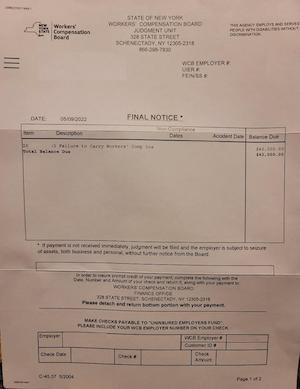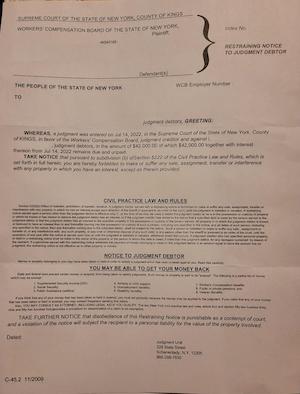How We Fight a New York Workers’ Compensation Judgment

In New York, a person can get an eye-popping Workers’ Compensation Judgment from the state without so much as a court hearing or much of a notice. What happens is, you first get a final notice in the mail, and the next thing you get is a judgment. They can be for a very high amount, in the tens or even hundreds of thousands of dollars. Because the state calculates the penalty at $2,000 per day.

There is no hearing or a judge or a jury, it just happens automatically.
These judgments can happen for innocent things that people don’t know require workers’ compensation, such as opening your own business and working as a sole employee, or having a nanny.
We fight New York Workers’ Compensation judgment by doing an appeal (has to be done within 30 days) or by filing a bankruptcy.
How we fight a New York Workers’ Compensation Judgment depends on the type of judgment you received. The appeals process for a workers’ compensation judgment can either be an appeal to the Board Panel or an application for rehearing or reopening with the Board.
If you still receive an unfavorable judgment with the Board Panel, you can either appeal it to the Full Board or the Appellate Division, Third Department of the Supreme Court, depending on the circumstances of your case.
The last resort is an appeal to the New York Court of Appeals, which the Court of Appeals can review mandatorily or by permission, depending on whether there was a dissent in the Appellate Division of the Supreme Court.
Going through the entire process of appeal, however, can be expensive, especially when done with a lawyer. For this reason, having a lawyer at the first instance to help you craft your arguments and defense can save you tens of thousands in legal fees, which can help you fight a New York workers’ compensation judgment.
If you do not have the money to pay for the judgment, we can also help you file for bankruptcy.
New York workers’ compensations claims
A New York workers’ compensation claim always begins with a notice to the employer within 30 days of the injury. After this notice, the worker files a workers’ compensation claim with the New York State Workers’ Compensation Board. The Board then sends a notice to the worker and all interested parties that a case has been created and assigned a case number. The employer and his insurer will then be given an opportunity to answer. The Board may or may not hold a hearing to determine the worker’s eligibility for compensation. For this reason, the employer or his insurer may just receive a final notice of judgment, holding them liable for the worker’s claims.
New York Workers’ Compensation Final Notice
Sometimes, an employer ignores the notice from the Board and fails to answer it within the time provided (usually 10 days). When this happens, a business can simply get an eye-popping Workers’ Compensation Judgment from the state without so much as a court hearing. You get a final notice in the mail, and the next thing you get is a judgment. They can be for a very high amount, in the tens or even hundreds of thousands of dollars.
When you don’t have workers’ compensation insurance, the Board, aside from the judgment, will add an additional minimum fine of $2000 per ten days that the insurance was not in effect.
What happens after a New York Workers’ Compensation Judgment
Once you receive a New York Workers’ Compensation Judgment, you have two options, depending on the circumstances of your case:
- Appeal to the Board Panel, or
- File an application for rehearing or reopening.
Appeal to the Board Panel
An appeal to the Board Panel is the usual form of review when one receives an unfavorable workers’ compensation judgment. An appeal should be made within 30 days from the filing date of the decision.
A Board Panel is composed of three members who will review the decision made at the hearing level. An appeal to the Board Panel will stay the decision with respect to the disputed amount. A stay means that your obligation to make payment of the disputed amount is suspended until a decision is made by the Board Panel. The amount you do not dispute in your appeal should already be paid. The Board Panel may choose to affirm, modify or reverse the decision.
Application for rehearing or reopening
When more than 30 days has lapsed from the decision, an application for rehearing or reopening is your remedy if you can allege any of the following, for as long as this application is filed within a reasonable time after the applicant received knowledge of the facts constituting the grounds upon which the application is being made:
- Certain material evidence was not available at the time of the hearing;
- There has been a change in the worker’s condition material to the issue involved;
- It is in the interest of justice.
Sometimes, when you are completely unaware that a case has been filed against your company and you just learn about it because a lien has been filed against your property, an application for rehearing or reopening is your remedy, for as long as you file it within a reasonable time from knowledge of the decision. This application is filed with the Board and not the Board Panel.
What happens after a Board Panel Decision
When you receive an unfavorable judgment from the Board Panel, you have two options:
- File an appeal with the Full Board; or
- File an appeal with the Appellate Division, Third Department of the Supreme Court.
In both cases, it must be filed within 30 days of the filing of the Board Panel Decision. There is no stay of the Board Panel Decision, while pending review from the Full Board or the Appellate Division, unless the Supreme Court issues a temporary restraining order or preliminary injunction.
Appeal with the Full Board
The Full Board can review your appeal either on a mandatory or discretionary basis. It is mandatory when one member in the Board Panel dissents. It is discretionary when the decision of the Board Panel is unanimous.
When an appeal to the Full Board is discretionary, it does not stop the period to appeal to the Appellate Division.
Appeal with the Appellate Division
An appeal to the Appellate Division is made via Notice of Appeal, within 30 days from the filing date of the Board Panel Decision. The respondent will have 30 days to file a rebuttal, and the appellant has another 10 days to file the reply. The Appellate Division, composed of five judges, can affirm, modify, or reverse the Board Panel Decision.
What happens after the Appellate Division Decision
An appeal to the Court of Appeals can be made when there is a dissent in the Appellate Division. Otherwise, the New York Court of Appeals can only hear your case by permission. The period to appeal is 30 days from entry of the Appellate Division decision.
The legal strategy to fight your New York workers’ compensation judgment depends on the unique circumstances of your case and at what stage in the appeals process you are in.
Bankruptcy
Sometimes, you may be really in error and have not insured your employees for workers’ compensation. You may not be able to afford paying off the judgment which can reach tens, if not hundreds of thousands of dollars. With no insurance to pay off this judgment, you may have no other option than to file for bankruptcy. This is a viable alternative which we can also help you with. In bankruptcy, you may be able to keep some of your property that is exempt.
Our strategy to help you fight a New York workers’ compensation judgment
If you have never received any notice and just learned about your judgment because a lien has been filed against your property, then we file an application for rehearing or reopening with the Board. This is allows to reopen and reargue your case, giving you the opportunity to be heard.
When you have fully argued your case before the Board, our strategy is to file an appeal with the Board Panel, especially since an appeal to the Board Panel stays the execution of the judgment, with regard to the disputed amount. An appeal requires a thorough review of your case and meticulous research to see if you have fully raised all your arguments and have strongly backed it up with case precedent.
If you are truly in error and have not insured your employees for workers’ compensation so no insurer is available to pay for your liabilities, bankruptcy is a viable alternative.
New York workers’ compensation judgments can happen for innocent things that people don’t know require workers’ compensation, such as opening your own business and working as a sole employee, or having a nanny. We fight New York Workers’ Compensation judgment by doing an application for rehearing or reopening, an appeal (has to be done within 30 days), or by filing a bankruptcy.
If you need to fight a New York Workers’ Compensation judgment, we at the Law Offices of Albert Goodwin are here for you. We have offices in New York City, Brooklyn, NY and Queens, NY. You can send us an email at [email protected] or call us at 212-233-1233.
